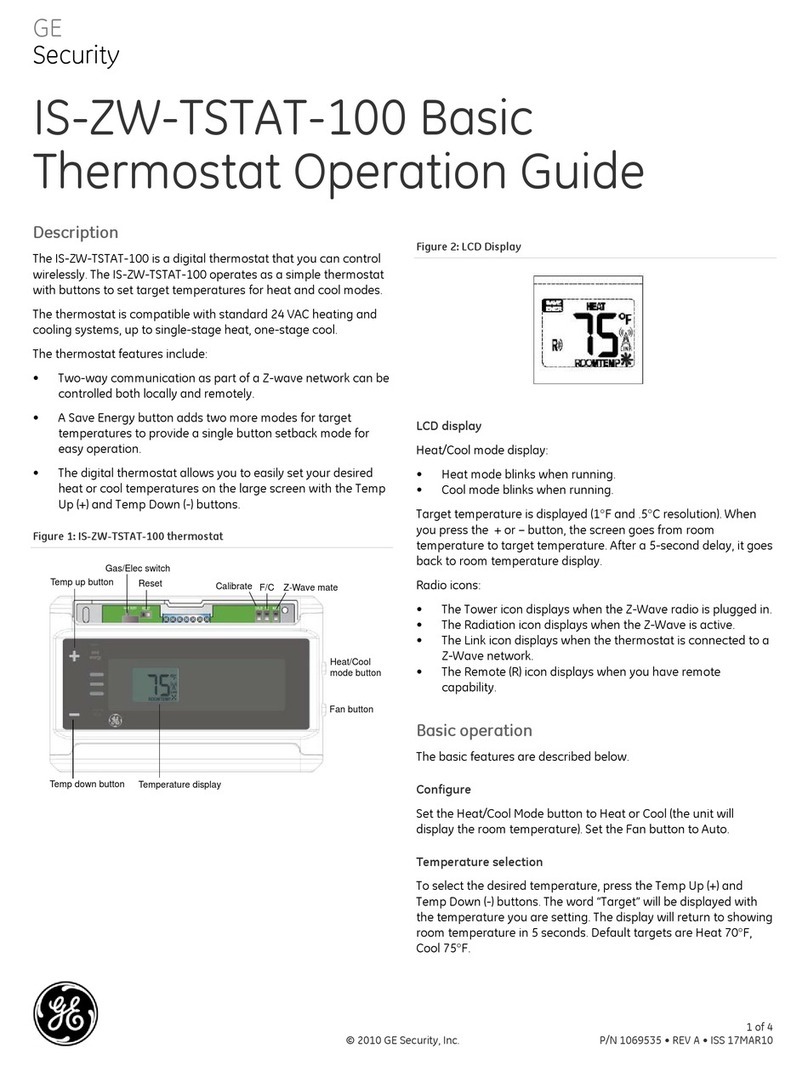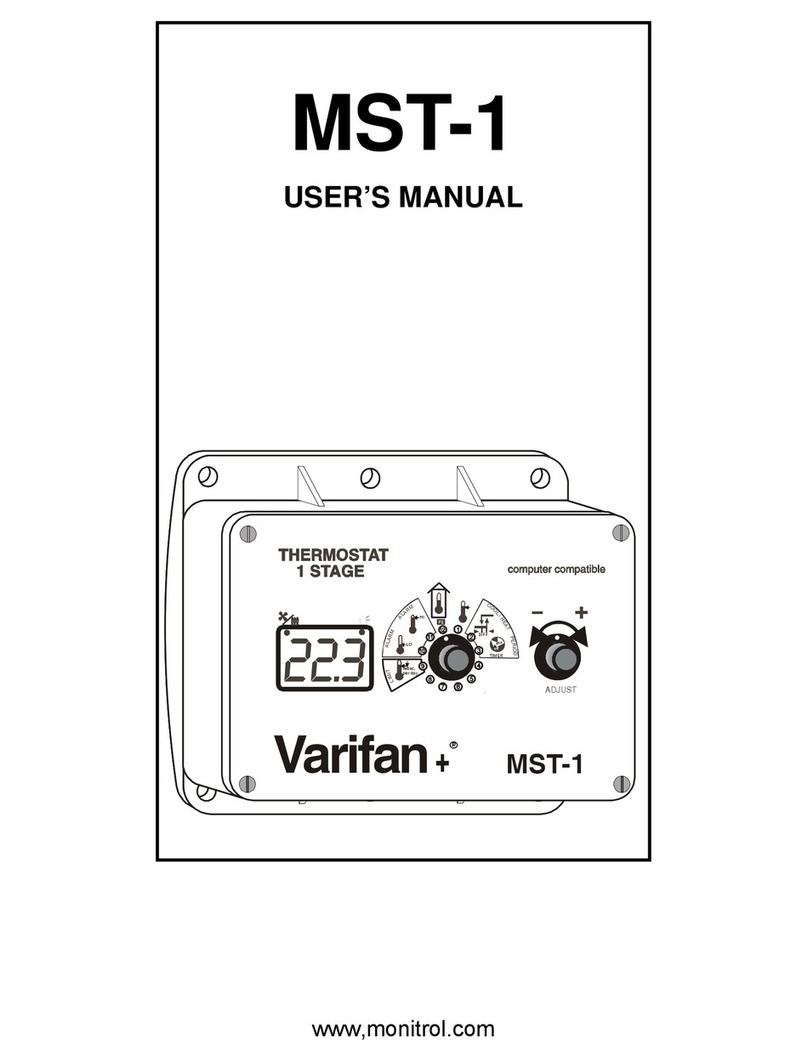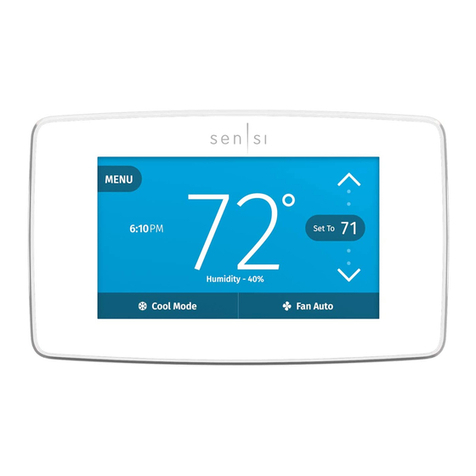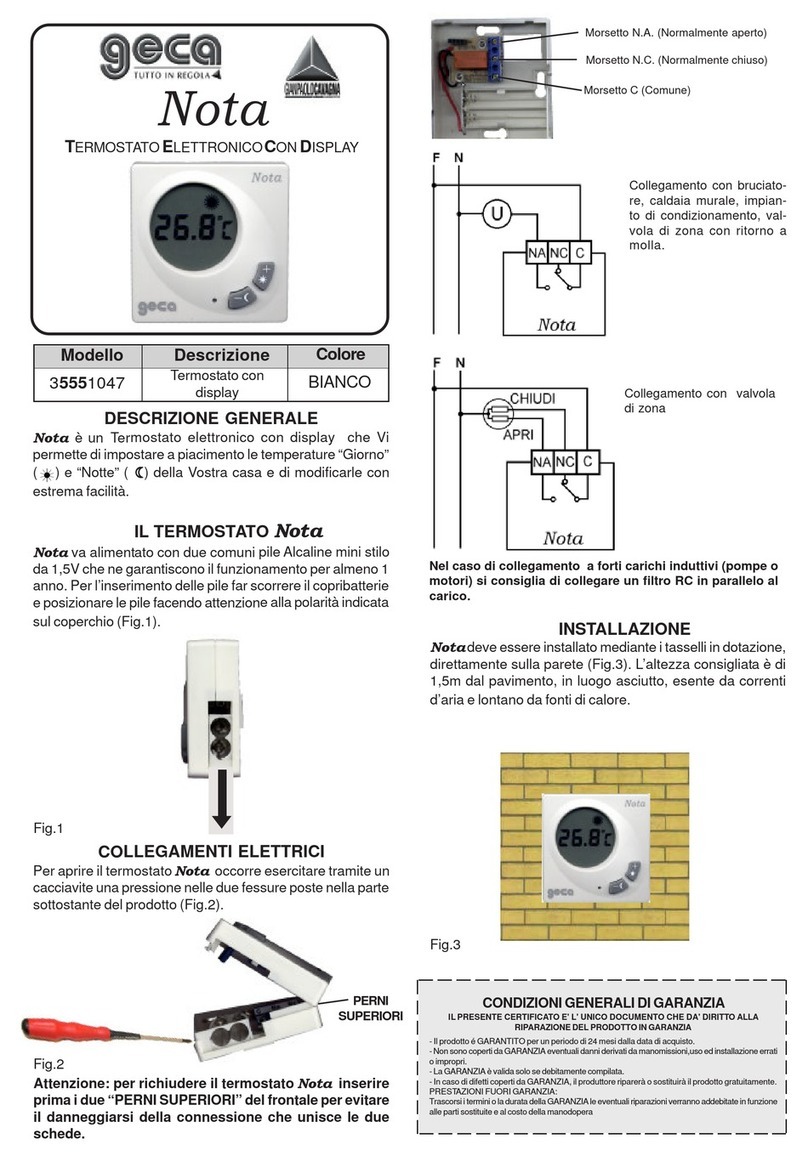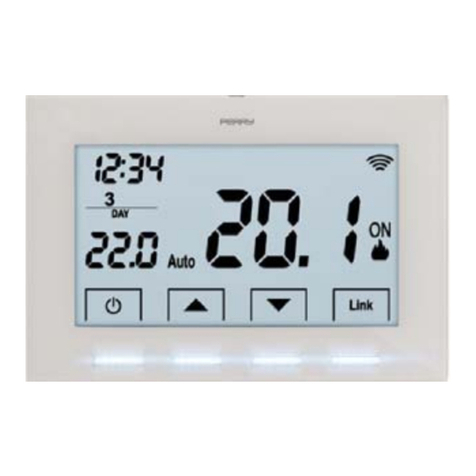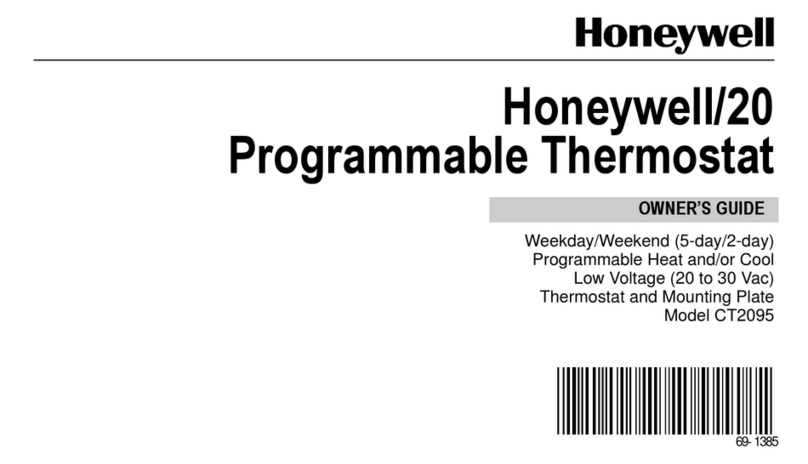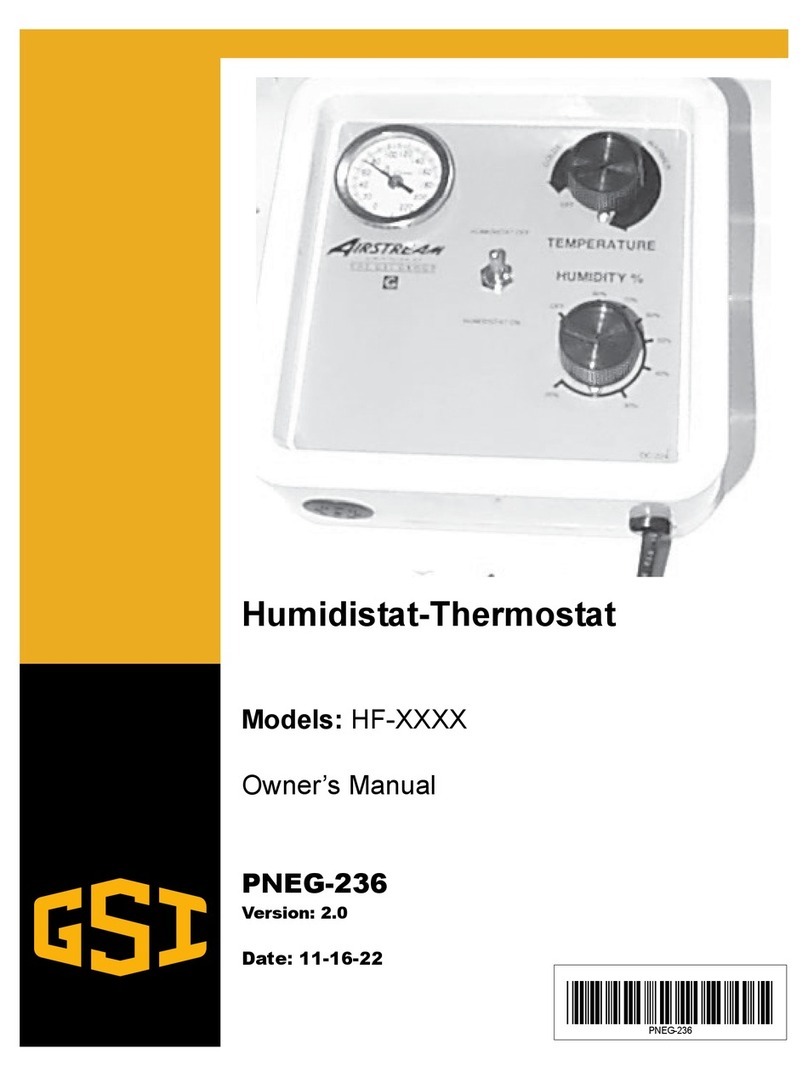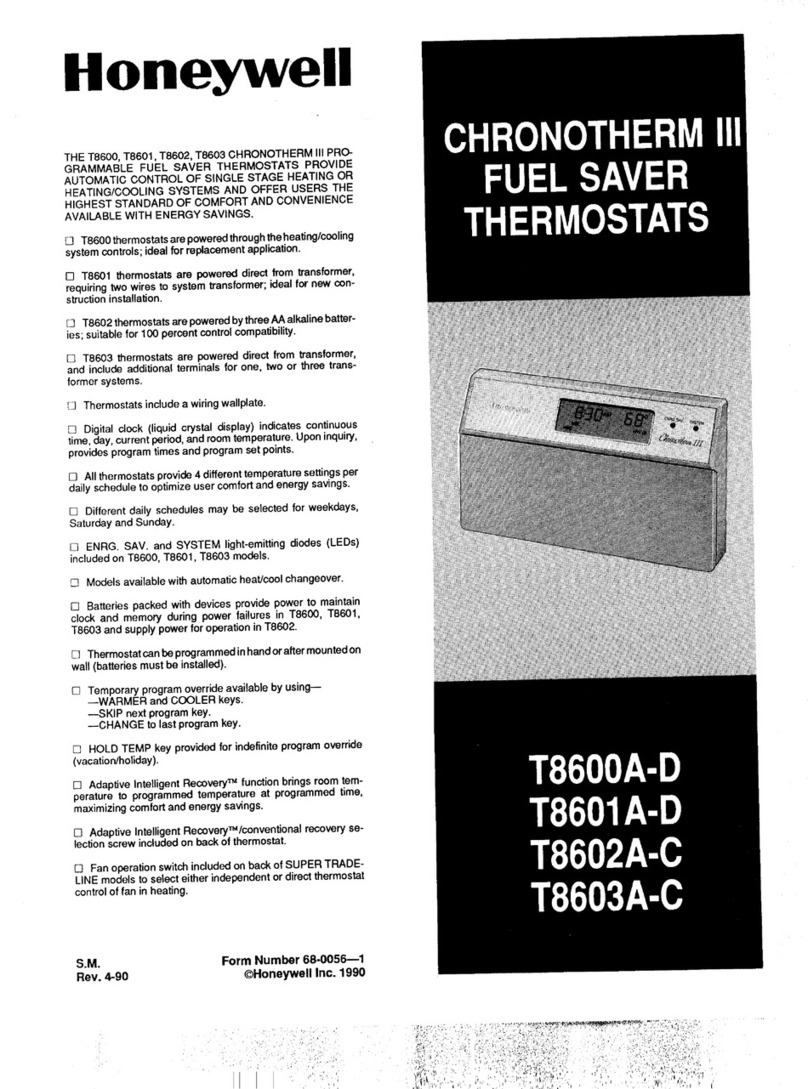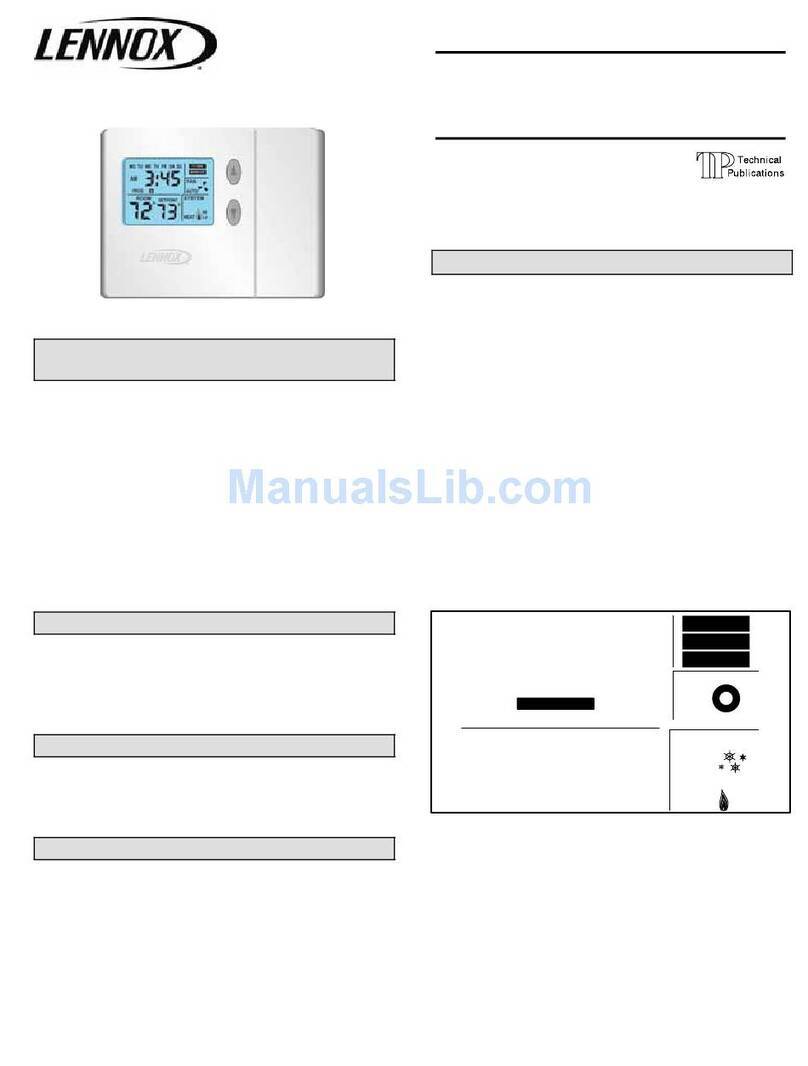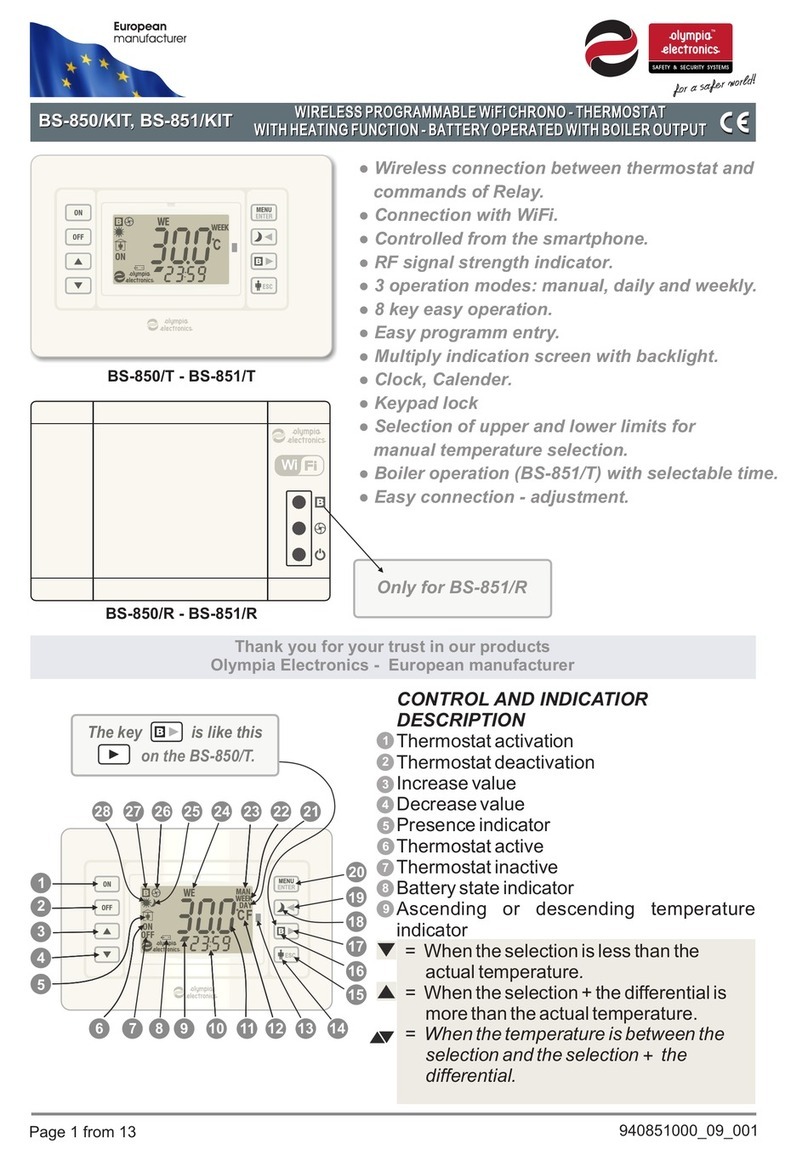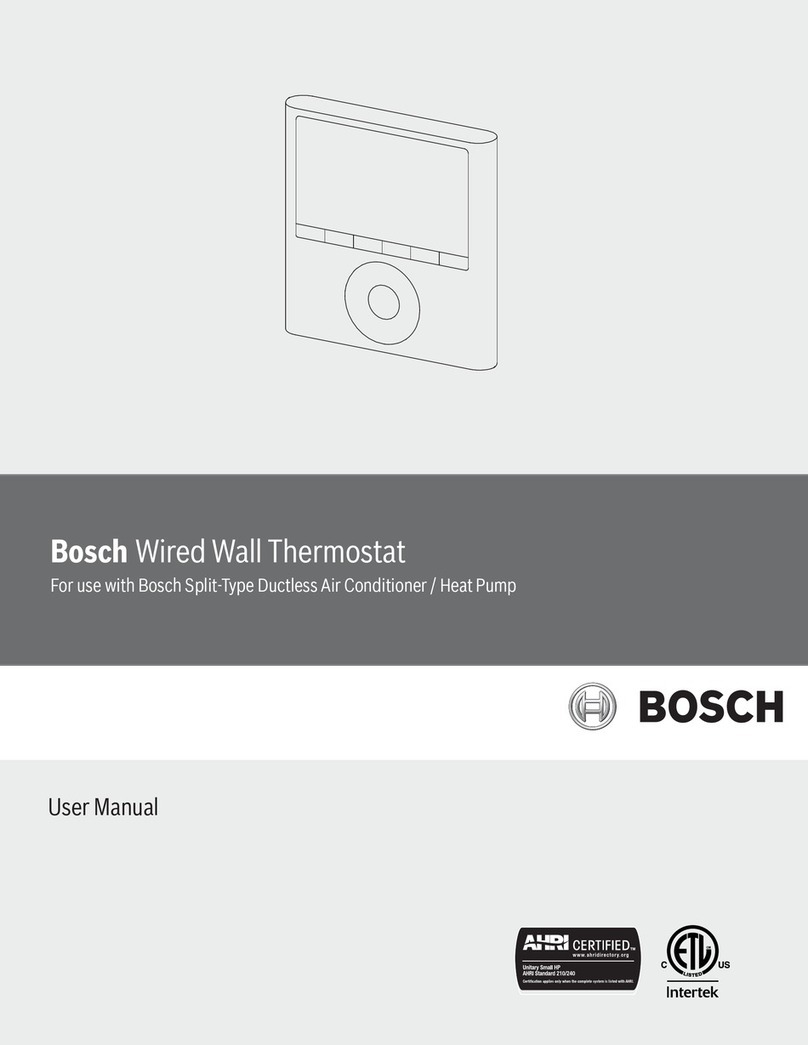GE Security IS-ZW-TSTAT-100 Assembly instructions

GE
Security
IS-ZW-TSTAT-100 Basic
Thermostat Installation Sheet
Description
The IS-ZW-TSTAT-100 is a digital thermostat that you can control
wirelessly. The IS-ZW-TSTAT-100 operates as a simple thermostat
with buttons to set target temperatures for heat and cool modes.
The thermostat is compatible with standard 24 VAC heating and
cooling systems, up to single-stage heat, one-stage cool. The
thermostat is designed for indoor use only.
© 2010 GE Security, Inc.
1 of 6
P/N 1069534 • REV A • ISS 17MAR10
The thermostat CANNOT be used with a line-voltage system. Line
voltage or high voltage thermostat systems run off your home’s
120 V or 240 VAC power and are not particularly common as they
are used primarily for electric resistance heating systems. The
wires on a line-voltage system will be thicker electrical wires like
those used for a light switch or outlet. Low voltage wiring looks like
telephone or speaker wire. If you are not certain of the type of
system, call an electrician or HVAC service.
The thermostat features include:
• Two-way communication as part of a Z-wave network can be
controlled both locally and remotely.
• A Save Energy button adds two more modes for target
temperatures to provide a single button setback mode for
easy operation.
• The digital thermostat allows you to easily set your desired
heat or cool temperatures on the large screen with the Temp
Up (+) and Temp Down (-) buttons.
Figure 1: IS-ZW-TSTAT-100 Basic Thermostat
Temp up button
Temp down button Temperature display
Heat/Cool
mode button
Fan button
Gas/Elec switch
Reset Calibrate
F/C
Z-Wave mate
Terminals
Installation
Caution: To avoid electrical shock and to prevent damage to the
furnace, air conditioner, and thermostat, disconnect the power
supply before beginning work. You can do this at the circuit
breaker, or at the HVAC system.
Note: Verify the current system is operating properly before tuning
off the power.
• Do not turn electricity back on until work is completed.
• Do not short (jumper) across electric terminals at the control
on the furnace or air conditioner to test the system. This may
damage the thermostat.
• All wiring must conform to local codes and ordinances.
• The thermostat relay load should be limited to 1.0 amp;
higher amperage may cause damage to the thermostat.
Tools
You will need a small Phillips screwdriver.
New construction installations
For new installations (new construction), contact your local HVAC
or electrician to wire and mount the thermostat.
For new installations and for relocating an existing thermostat,
follow these guidelines:
• Determine what type of HVAC system you have.
• Locate the thermostat on an inside wall, about 5 ft. (1.5 m)
above the floor.
• Do not locate the thermostat in unusual heating conditions.
• Do not locate in unusual cooling conditions.
• Do not locate the thermostat in a damp area. This can lead to
corrosion that will shorten the thermostat life.
• Do not locate the thermostat where air circulation is poor.
• Do not install the thermostat until all construction and
painting is completed.
The thermostat does not require leveling.

Replacement installationsReplacement installations
For replacement installations, mount the IS-ZW-STAT-100 in place
of the existing thermostat. You must have a “C” wire or other 24
VAC power available at the IS-ZW-TSTAT-100 location. A new
location will require moving your wiring.
For replacement installations, mount the IS-ZW-STAT-100 in place
of the existing thermostat. You must have a “C” wire or other 24
VAC power available at the IS-ZW-TSTAT-100 location. A new
location will require moving your wiring.
To remove the old thermostat:To remove the old thermostat:
1. Switch off electricity to the furnace and air conditioner.1. Switch off electricity to the furnace and air conditioner.
2. Remove the cover from the old thermostat.2. Remove the cover from the old thermostat.
Most are snap-on types and simply pull off. Some have
locking screws on the side or front. These must be loosened.
Most are snap-on types and simply pull off. Some have
locking screws on the side or front. These must be loosened.
3. Do not remove the wires. Note the letters printed near the
terminals.
3. Do not remove the wires. Note the letters printed near the
terminals.
4. Attach labels (enclosed) for each wire for identification.4. Attach labels (enclosed) for each wire for identification.
Read the instructions carefully before removing any wiring
from the existing thermostat. There is no standard color code
for the wires. When removing wires from their terminals,
ignore the color of the wires and label them by the terminal
where they were connected.
Read the instructions carefully before removing any wiring
from the existing thermostat. There is no standard color code
for the wires. When removing wires from their terminals,
ignore the color of the wires and label them by the terminal
where they were connected.
Label the wires one at a time. You must label all of the wires
before you proceed. This may require you to find the “other
end” connection for each wire on your heating or air
conditioning equipment and read the label there. See “ top
and bottom cover sections.
Label the wires one at a time. You must label all of the wires
before you proceed. This may require you to find the “other
end” connection for each wire on your heating or air
conditioning equipment and read the label there. See “
Wiring” below for information on wire labels from different
HVAC system makers.)
Wiring” below for information on wire labels from different
HVAC system makers.)
5. With all wires labeled, remove them from the old unit.5. With all wires labeled, remove them from the old unit.
Make sure the wires do not fall back inside the wall. You can
wind them around a pencil to keep them from falling (see
Figure 2 below).
Make sure the wires do not fall back inside the wall. You can
wind them around a pencil to keep them from falling (see
Figure 2 below).
6. Loosen all screws on the old thermostat and remove it from
the wall.
6. Loosen all screws on the old thermostat and remove it from
the wall.
Figure 2: Label wiresFigure 2: Label wires
top
and bottom cover sections.
Note: A C wire or 24 VAC power is required for the IS-ZW-TSTAT-
100 to operate. If you do not have a C wire, you can run a new
wire from the HVAC to the IS-ZW-TSTAT-100.
The wire marked “C” will allow your thermostat to power up. If you
do not connect or have a “C” wire, you can run a new wire from
the HVAC to the IS-ZW-TSTAT-100. Battery power is designed for
power loss backup and not the primary power source. If you do
connect the C wire to the thermostat, this will extend battery life.
See “Wiring” on page 3 for details on the different types of HVAC
wiring your system may have.
Prepare the wires
Use the following guidelines for safe and secure wire connections:
• You will need at least 2.6 in. of wire for each of your
connections to the IS-AW-TSTAT-100. If you do not have
enough wire, splice additional wire to allow enough slack.
• Remove insulation 1/8 in. from the tip of each wire.
• Take care not to damage the wire labels when you handle the
wires.
• Do not allow wires to touch each other or other parts on the
thermostat.
• Fan out the wires below the wall opening (see Figure 3 below)
so that the C wire is above the C terminal, the W above the W
terminal, etc. This allows the thermostat to fit snug to the
wall.
• Position the wires behind the thermostat and up over the
terminal area. Do not bunch wires behind the thermostat.
Feed any slack back into the wall opening.
Figure 3: Prepare wires
From furnace
CWYRH G
2.6 in.
To connect the wires:
1. Connect the labeled wires only to a terminal with the same
letter label.
2. Insert the wire in the terminal well and tighten the screw
securely.
Do not over-tighten (this could cut the wire).
To mount the thermostat to the wall:
1. Remove the top and bottom cover sections on the front of the
thermostat to expose the mounting holes.
2. Hold the thermostat against the wall, with the wires coming
over the top above the terminal block.
The thermostat will cover the hole in the wall. Position the
thermostat for best appearance.
3. Attach the thermostat to the wall with the screws provided.
Mark first, and then drill a 3/16 in. (4.8 mm) hole for the insert
at each screw location, then mount the thermostat.
If you are mounting the thermostat to sheet rock or if you are
using the old mounting holes, use the plastic anchors
provided.
4. Replace the top and bottom cover sections.
2 of 6 P/N 1069534 • REV A • ISS 17MAR10

Wiring
Note: For wiring questions, call the thermostat hotline at 888-819-
4135.
The table below describes the terminals on the IS-ZW-TSTAT-100
Basic Thermostat.
C 24 volt common
W First stage heat relay
Y First stage cool relay
RH Power for heat
RC Power for heat
G Fan relay
The wire translation chart for the IS-ZW-TSTAT-100 is provided
below:
C, X > C
W, H > W
Y, C, M > Y
R, V, 4, RH > RH
RC > RC
G, F > G
Tip: For Trane systems with a B wire, the B wire is typically the C
wire. If you have conventional heat and you have a B wire, the B
goes to C.
Tip: If your system is a heat pump with both an O and B wire, the
IS-ZW-TSTAT-100 Basic Thermostat will not control your system.
Consider the IS-ZW-TSTAT-300 Advanced Thermostat as an
alternative.
The following sections describe different HVAC wiring systems.
To connect a two-wire system (C, W, RH, or R) to the
thermostat:
1. Connect the R (or RH) wire to the RH terminal on the
thermostat. This connects the heater power.
2. Connect the W wire to the W terminal on the thermostat. This
connects the heater control line.
Your system is now connected to the thermostat.
Figure 4: Two-wire connections
CRC
Thermostat
RH W YG
Heat power Heat
HVACsystem
W
jumper
wire
CR
To connect a three-wire system (C, W, RH or R, G) to the
thermostat:
1. Connect the R (or RH) wire to the RH terminal on the
thermostat. This connects the heater power.
2. Connect the W wire to the W terminal on the thermostat. This
connects the heater control line.
3. Connect the G wire to the G terminal on the thermostat. This
connects the fan.
Your system is now connected to the thermostat.
Figure 5: Three-wire connections
CRC
Thermostat
RH W YG
Heat power Heat Fan
HVACsystem
W G
jumper
wire
CRC
To connect a four-wire system (C, W, G, R or RH, Y) to the
thermostat:
1. Connect the Y wire to the Y terminal on the thermostat. This
connects the cooler compressor.
2. Connect the R (or RH) wire to the RH terminal on the
thermostat. This connects the heater/cooler power.
3. Connect the W wire to the W terminal on the thermostat. This
connects the heater control line.
4. Connect the G wire to the G terminal on the thermostat. This
connects the fan.
Your system is now connected to the thermostat.
Figure 6: Four-wire connections
CRC
Thermostat
RH W YG
Heat power Heat Cool
comp Fan
HVACsystem
WY G
jumper
wire
CRC
P/N 1069534 • REV A • ISS 17MAR10 3 of 6

To connect a five-wire system (C, W, G, RC, RH, Y) to the
thermostat:
1. Remove the orange jumper wire.
2. Connect the Y wire to the Y terminal on the thermostat. This
connects the cooler compressor.
3. Connect the RH wire to the RH terminal on the thermostat.
This connects the heater power.
4. Connect the RC wire to the RC terminal on the thermostat.
This connects the cooling power.
5. Connect the W wire to the W terminal on the thermostat. This
connects the heater control line.
6. Connect the G wire to the G terminal on the thermostat. This
connects the fan.
Your system is now connected to the thermostat.
Figure 7: Five-wire connections
CRC
Thermostat
RH W YG
Cool power
Heat power
Heat Cool
comp Fan
HVACsystem
RC RH WY G
Remove
jumper
wire
C
Batteries
The IS-ZW-TSTAT-100 requires three AA Alkaline batteries.
Batteries are used for backup in case of power loss. We do not
recommend the batteries as the primary source of power.
To install the batteries:
1. Press the Heat/Cool Mode button to Off and press the Fan
button to Auto.
2. Remove the bottom cover section to access the battery
compartment.
3. Install three AA Alkaline batteries according to the polarity
noted in the battery compartment. (Do not use rechargeable
batteries.)
4. Replace the bottom cover.
Replace the batteries when the red Low Battery LED indicator
blinks or once a year.
Caution: The thermostat will go “off” if the batteries die. This could
expose your house to unexpected heat or cold.
Testing
Follow these procedures to verify you have correctly installed the
thermostat (see Figure 1 on page 1).
To check the fan (if you connected the G wire-fan relay):
1. Press the Fan button to On.
2. Verify that air is blowing from the system.
3. Return the Fan button to the Auto selection for normal
operation.
To check heat mode:
1. Press the Heat/Cool Mode button to Heat.
2. Press the + button to raise the target temperature to 90°F.
Allow the system 2 minutes to respond.
3. Verify that heat is blowing from the system.
4. Return the Heat/Cool Mode button to Off.
Leave off for 4 minutes before checking the cool mode.
To check cool mode:
Note: Do not operate AC if the outside temperature is below 65°F.
1. Press the Heat/Cool Mode button to Cool.
2. Press the blue (-) button to lower the cool target temperature
to 50°F.
Allow the system 5 minutes to respond.
3. Verify that cool air is blowing from the system.
4. Return the Heat/Cool Mode button to Off.
If you have electric heat, locate the Gas/Elec switch. Move the
selector jumper to the Elec position (see Figure 1 on page 1).
Calibration
The IS-ZW-TSTAT-100 thermostat comes from the factory
calibrated to ±1°of actual temperature. If you want the
thermostat to display the same temperature as another
thermostat in the home, you can adjust its calibration.
To change the calibration:
1. Remove the top cover section.
2. Locate the Calibration switch and slide it to the On position.
The current calibration factor is (±) of the IS-ZW-TSTAT-100
will appear in the LCD display.
3. Push the Up or Down arrows until the desired calibration
factor is reached.
4. Slide the Calibration switch to the Off position. The new
calibrated temperature will be displayed on the LCD.
5. Replace the top cover section.
Reset
The Reset button (located under the top cover) defaults all
programming to target temperatures (heat 70°F, cool 75°F).
4 of 6 P/N 1069534 • REV A • ISS 17MAR10

Troubleshooting
The display is not coming on.
• Make sure there is a good set of name brand alkaline
batteries (Duracell, Energizer) in the unit.
• If a C wire is connected, remove it and see if the thermostat
works on batteries alone (C wire may be bad).
The fan is not working in heat mode.
• Turn the Fan button to the On position and see if it comes on.
If so, is the heat blowing? If yes, check to see that the
Gas/Elec switch is in the Elec position, if not put it there and
reset the thermostat using the reset button.
• If the fan fails to start in the on position, there may be a
problem with the fan or fan wire (G) connection. To test,
remove the RH/RC wire and the G wire and twist them
together. The fan should come on, if not the problem is not in
the thermostat.
There is no heat (in a conventional heating system).
1. Turn off the power to the thermostat.
2. Remove the top cover of the thermostat.
3. Remove the RH and W wires, strip them back so that some
copper is showing, and twist the RH and W wires together.
4. Turn the power back on and let it run for 15 minutes (during
this time, the furnace should run non-stop for the full time the
wires are together).
5. If it works correctly, rewire the thermostat (make sure the
wires go through both holes and tighten them down). Then
pull up on the wire to make sure you have a good connection.
6. If the furnace fails to start or stops before you take the wires
apart, you have a furnace problem and the thermostat is
okay.
There is no cooling (in a conventional AC system).
1. Turn off the power to the thermostat.
2. Remove the top cover of the thermostat.
3. Remove the RC, Y, and G wires, strip each wire back so some
copper is showing, and twist them together.
4. Turn the power back on. The compressor outside should start
along with the inside fan. If it starts, let it run for 5 to 10
minutes and make sure it blows cold air.
5. If it works correctly, rewire the thermostat (make sure the
wires go through both holes and tighten them down).
6. If the AC fails to turn on or blow warm air, then the problem is
with the AC system.
Specifications
Voltage 24 VAC (supplied via the C wire)
Backup batteries Three AA Alkaline batteries (Duracell, Energizer)
(do not use rechargeable batteries)
Dimensions (W × H × D) 5.5 × 3.5 × 1.5 in. (140 × 89 × 38 mm)
Operating environment
Temperature
Relative humidity
Indoor use only
32 to 104°F (0 to 40°C)
10 to 90% noncondensing
FCC regulatory information
This equipment has been tested and found to comply with the limits for a
Class B digital device, pursuant to Part 15 of the FCC Rules. These limits are
designed to provide reasonable protection against harmful interference in
a residential installation. This equipment generates, uses, and can radiate
radio frequency energy, and if not installed and used in accordance with
the instructions, may cause harmful interference to radio communications.
However, there is no guarantee that interference will not occur in a
particular installation. If this equipment does cause harmful interference to
radio or television reception, which can be determined by turning the
equipment off and on, the user is encouraged to try and correct the
interference by one or more of the following measures:
• Reorient or relocate the receiving antenna.
• Increase the separation between the equipment and receiver.
• Connect the equipment into an outlet on a circuit different from that
to which the receiver is connected.
Consult the dealer or an experienced radio/TV technician for help.
FCC ID: QO8-ZWave-0210
IC regulatory information
This Class B digital apparatus meets all requirements of the Canadian
Interference Causing Equipment Regulations. Operation is subject to the
following two conditions: (1) this device may not cause harmful
interference, and (2) this device must accept any interference received,
including interference that may cause undesired operation of the device.
IC: 4714A-ZWave-0210
Contact information
For contact information see our Web site: www.gesecurity.com.
P/N 1069534 • REV A • ISS 17MAR10 5 of 6

6 of 6 P/N 1069534 • REV A • ISS 17MAR10
Table of contents
Other GE Security Thermostat manuals
Popular Thermostat manuals by other brands
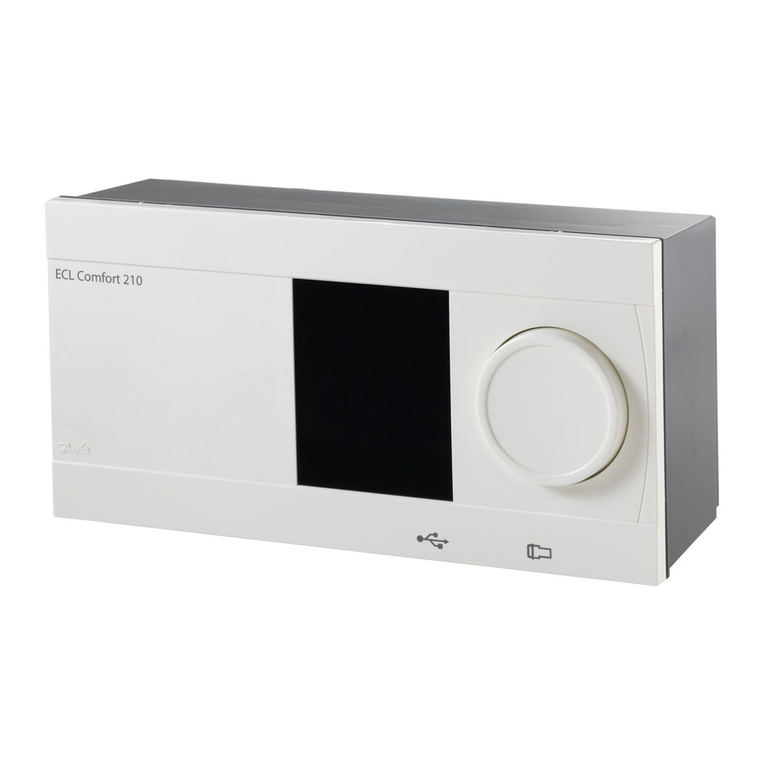
Danfoss
Danfoss ECL Comfort 210 operating guide
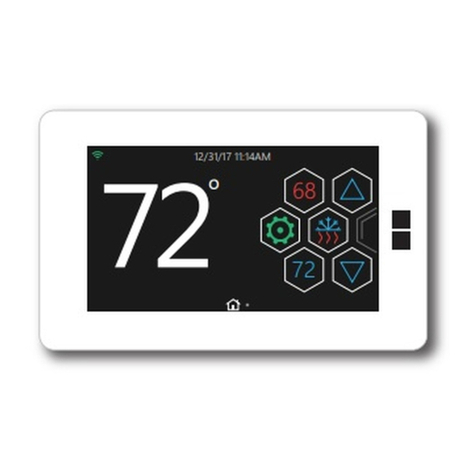
York
York Hx 3 S1-THXU280 User's information manual
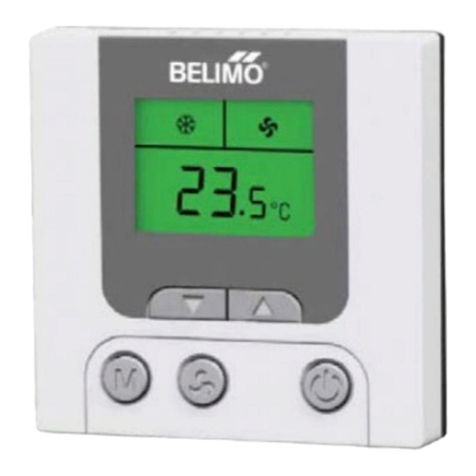
Belimo
Belimo EXT-RCF-24 installation manual

Lennox
Lennox iHarmony 17A30 Installation and setup guide

AKO
AKO 226.0120 Series Mounting and Servicing Instructions
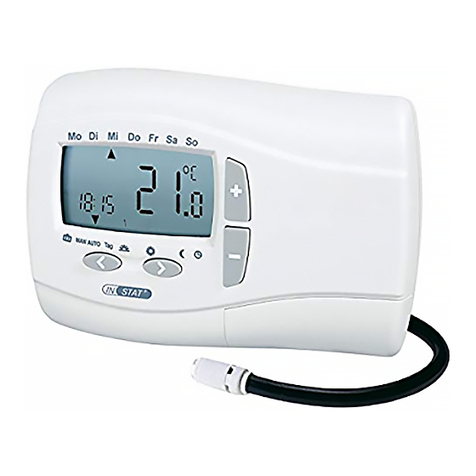
Heimeier
Heimeier INSTAT + 3R User and installation guide
